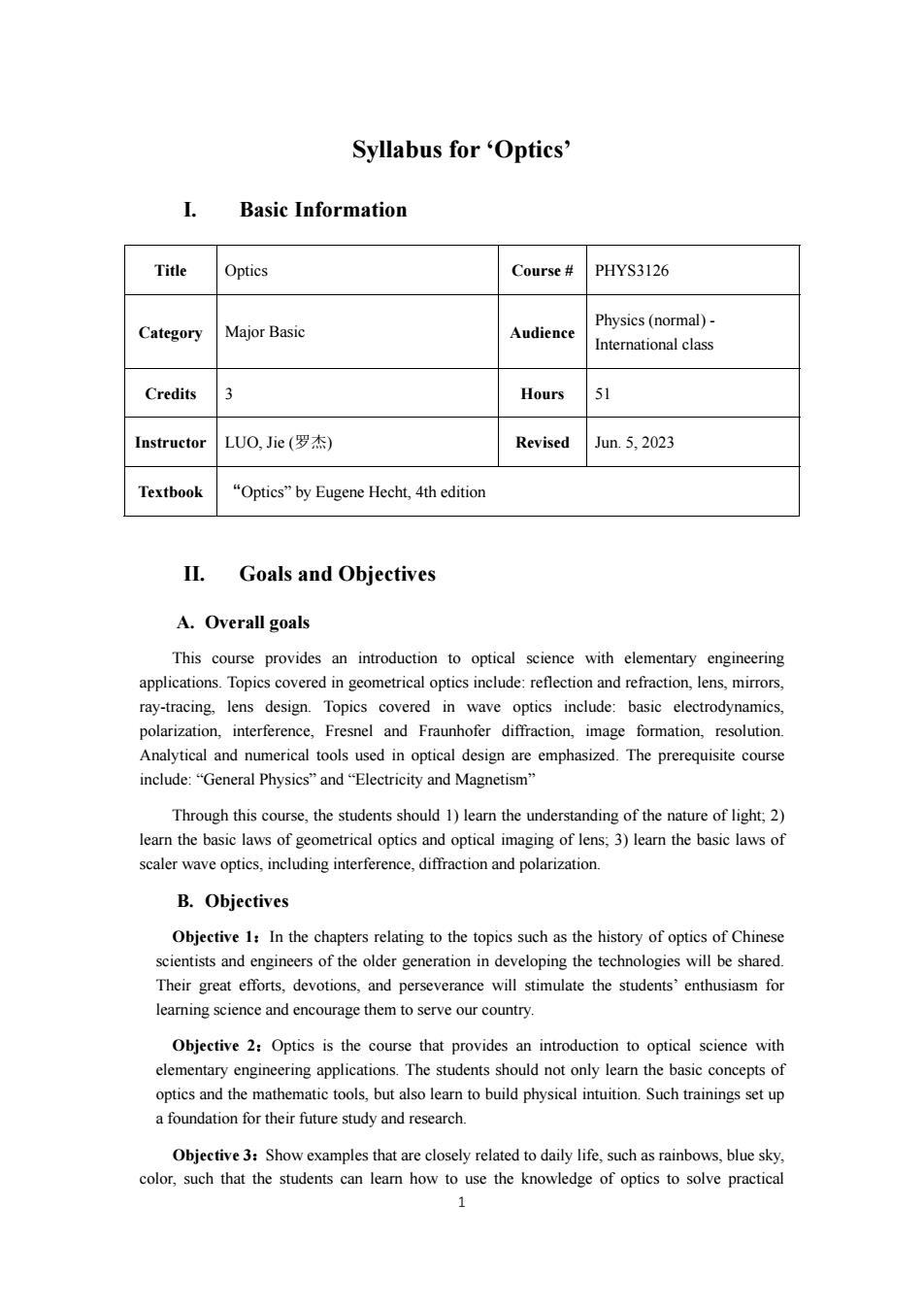
Syllabus for‘Optics' Basic Information Title Optics Course# PHYS3126 Category Major Basic Physics(normal) Audience International class Credits 3 Hours 51 Instructor LUO,Jie(罗杰) Revised Jun.5,2023 Texthook “Optics”by Eugene Hecht,4 thedition Goals and Objectives A.Overall goals This course provides an introduction to optical science with elementary engineering applications. overed in geometrical optics polarization,interference,Fresnel and Fraunhofer diffraction,image formation,resolution Analytical and numerical tools used in optical design are emphasized.The prerequisite course include:“General Physics”and“Electricity and Magnetism” Through this course,the students should 1)leamn the understanding of the nature of light;2) ear the basic laws of geometrical optics and optical imaging of)eam the basic lawso scaler wave optics,including interference,diffraction and polarization B.Objectives In the chapers relating to the topics suc as the history of of Chinese scientists engin eer of generation n eveloping the techn ies will be share Their great efforts,devotions,and perseverance will stimulate the students'enthusiasm for leaming science and encourage them to serve our country. Objective 2:Optics is the course that provides an introduction to optical science with ntary engir eering applications.The students should ea the basic a foundation for their future study and research. Objective3:Show examples that are closely related to daily life,such as rainbows,blue sky. color,such that the students can leam how to use the knowledge of optics to solve practical 1
1 Syllabus for ‘Optics’ I. Basic Information Title Optics Course # PHYS3126 Category Major Basic Audience Physics (normal) - International class Credits 3 Hours 51 Instructor LUO, Jie (罗杰) Revised Jun. 5, 2023 Textbook “Optics” by Eugene Hecht, 4th edition II. Goals and Objectives A. Overall goals This course provides an introduction to optical science with elementary engineering applications. Topics covered in geometrical optics include: reflection and refraction, lens, mirrors, ray-tracing, lens design. Topics covered in wave optics include: basic electrodynamics, polarization, interference, Fresnel and Fraunhofer diffraction, image formation, resolution. Analytical and numerical tools used in optical design are emphasized. The prerequisite course include: “General Physics” and “Electricity and Magnetism” Through this course, the students should 1) learn the understanding of the nature of light; 2) learn the basic laws of geometrical optics and optical imaging of lens; 3) learn the basic laws of scaler wave optics, including interference, diffraction and polarization. B. Objectives Objective 1:In the chapters relating to the topics such as the history of optics of Chinese scientists and engineers of the older generation in developing the technologies will be shared. Their great efforts, devotions, and perseverance will stimulate the students’ enthusiasm for learning science and encourage them to serve our country. Objective 2:Optics is the course that provides an introduction to optical science with elementary engineering applications. The students should not only learn the basic concepts of optics and the mathematic tools, but also learn to build physical intuition. Such trainings set up a foundation for their future study and research. Objective 3:Show examples that are closely related to daily life, such as rainbows, blue sky, color, such that the students can learn how to use the knowledge of optics to solve practical
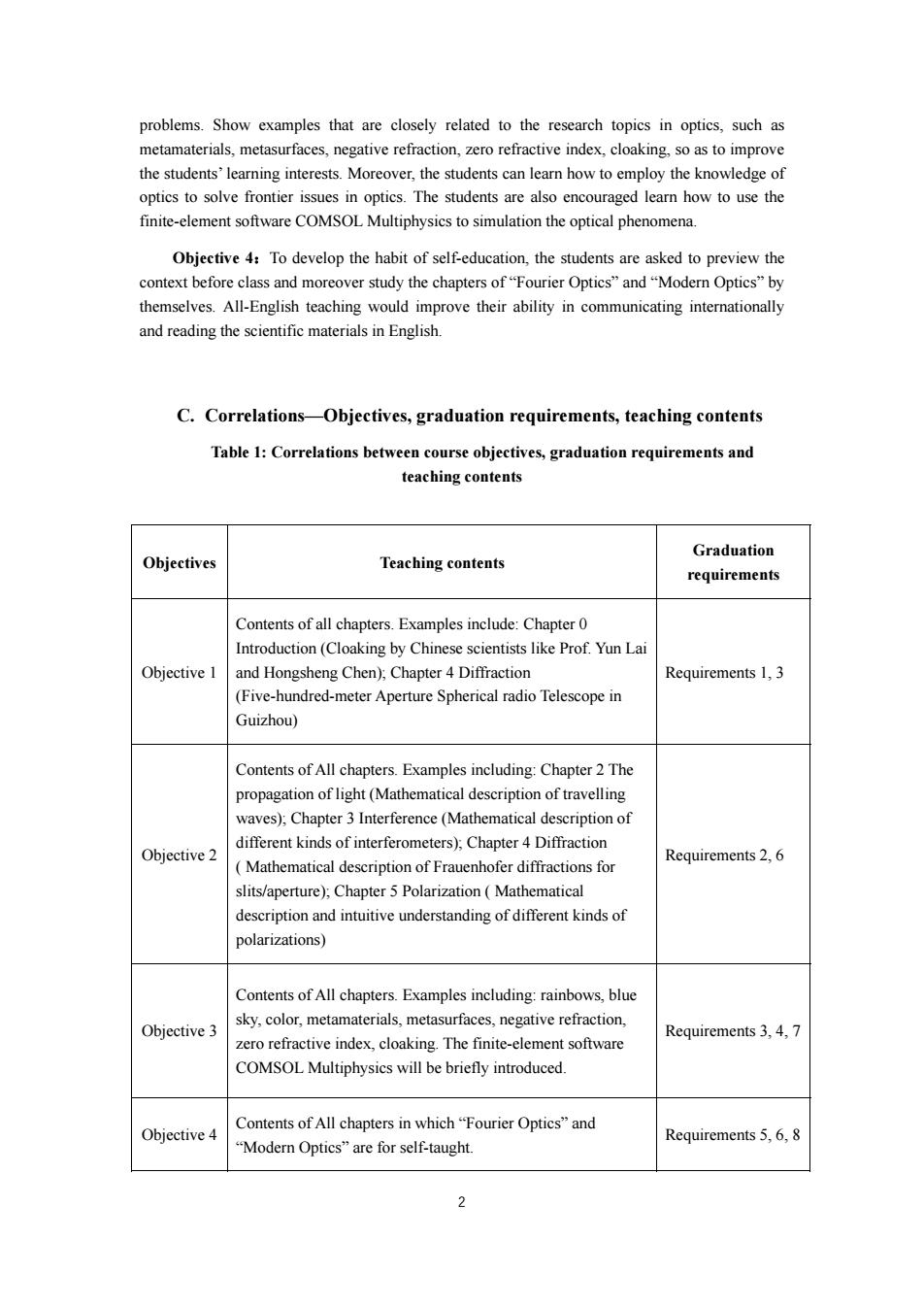
problems.Show examples that are closely related to the research topics in optics,such as ne owtm the tion,zero refractive index,cloaking.s the students optics to solve frontier issues in optics.The students are also encouraged learn how to use the finite-element software COMSOL Multiphysics to simulation the optical phenomena. Obiective 4:Tto develop the habit of self-education.the students are asked to preview the context before class and moreover study the chapters"Modem Optics"by themselves.All-English teaching would improve their ability in communicating interationally and reading the scientific materials in English. C.Correlations-Objectives,graduation requirements,teaching contents Table 1:Correlations between course objectives,graduation requirements and teaching contents Objectives Teaching contents Graduation requirements Contents of all chapters.Examples include:Chapter 0 Introduction(Cloak ng by Chin ese scientists like Prof.Yun Lai Objective 1 and Hongsheng Chen):Chapter4Diffraction Requirements 1,3 (Five-hundred-meter Aperture Spherical radio Telescope in Guizhou) Contents of All chapters.Examples including:Chapter 2The propagation of igt(Mathematical description of traveling waves);Chapter 3 Interference (Mathematical description of Objective2 different kinds of interferometers),Chapter 4 Diffraction (Mathematical description of Frauenhofer diffractions for Requirements2,6 slits/aperture)chapter 5 polarization mathematical descriptionand of polarizations) Contents of All chapters.Examples including:rainbows,blu sky.color,metamaterials.metasurfaces.negative refraction. Objective 3 Requirements 3.4.7 zero refractive index,cloaking.The finite-element software COMSOL Multiphysics will be briefly introduced. Objective4 Contents of All chapters in which"Fourier Optics"and Modemn Optics"are for self-taught Requirements5,6,8
2 problems. Show examples that are closely related to the research topics in optics, such as metamaterials, metasurfaces, negative refraction, zero refractive index, cloaking, so as to improve the students’ learning interests. Moreover, the students can learn how to employ the knowledge of optics to solve frontier issues in optics. The students are also encouraged learn how to use the finite-element software COMSOL Multiphysics to simulation the optical phenomena. Objective 4:To develop the habit of self-education, the students are asked to preview the context before class and moreover study the chapters of “Fourier Optics” and “Modern Optics” by themselves. All-English teaching would improve their ability in communicating internationally and reading the scientific materials in English. C. Correlations—Objectives, graduation requirements, teaching contents Table 1: Correlations between course objectives, graduation requirements and teaching contents Objectives Teaching contents Graduation requirements Objective 1 Contents of all chapters. Examples include: Chapter 0 Introduction (Cloaking by Chinese scientists like Prof. Yun Lai and Hongsheng Chen); Chapter 4 Diffraction (Five-hundred-meter Aperture Spherical radio Telescope in Guizhou) Requirements 1, 3 Objective 2 Contents of All chapters. Examples including: Chapter 2 The propagation of light (Mathematical description of travelling waves); Chapter 3 Interference (Mathematical description of different kinds of interferometers); Chapter 4 Diffraction ( Mathematical description of Frauenhofer diffractions for slits/aperture); Chapter 5 Polarization ( Mathematical description and intuitive understanding of different kinds of polarizations) Requirements 2, 6 Objective 3 Contents of All chapters. Examples including: rainbows, blue sky, color, metamaterials, metasurfaces, negative refraction, zero refractive index, cloaking. The finite-element software COMSOL Multiphysics will be briefly introduced. Requirements 3, 4, 7 Objective 4 Contents of All chapters in which “Fourier Optics” and “Modern Optics” are for self-taught. Requirements 5, 6, 8
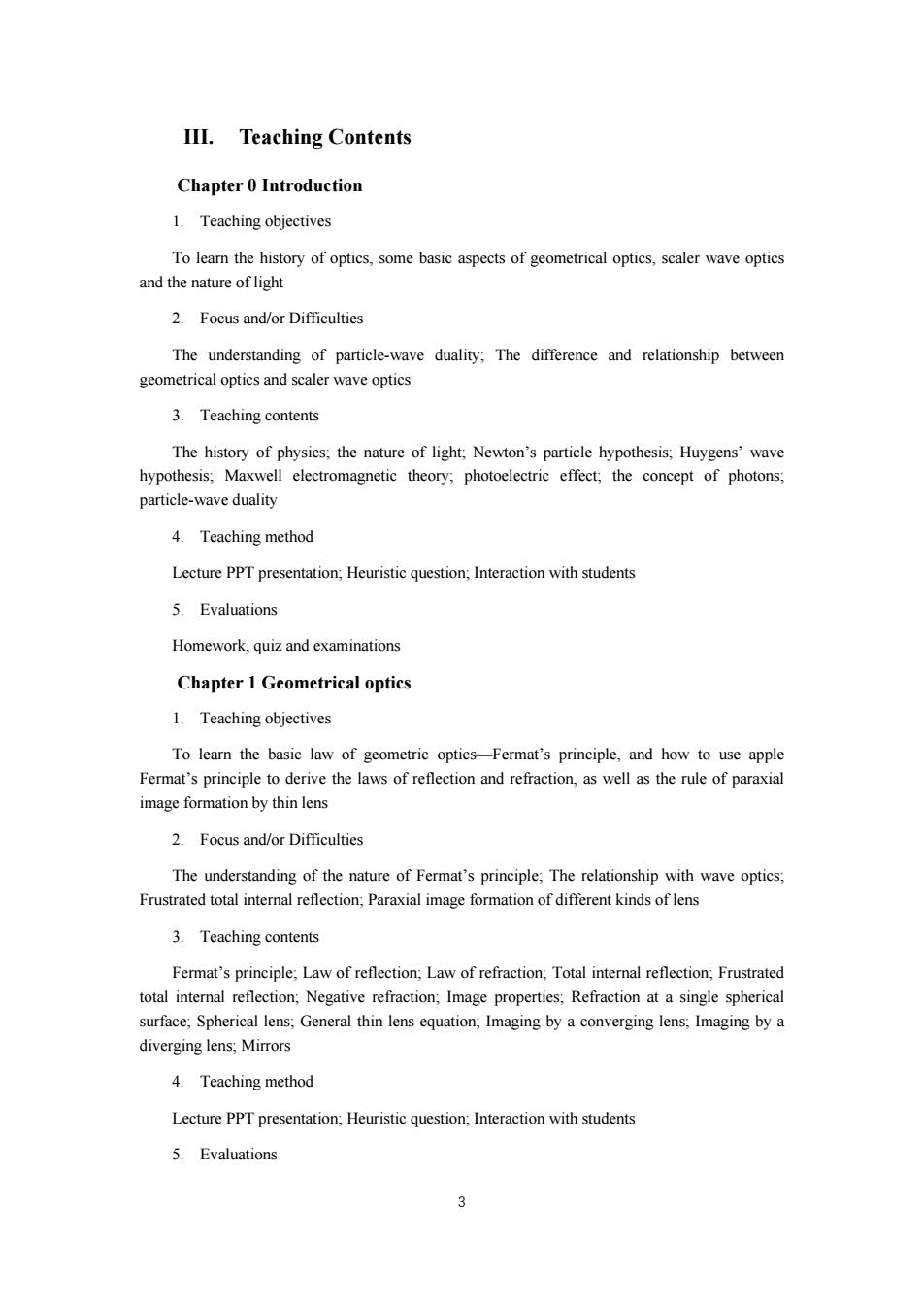
III.Teaching Contents Chapter0 Introduction 1.Teaching objectives To leam the history of optics,some basic aspects of geometrical optics,scaler wave optics and the nature of light 2.Focus and/or Difficulties The understanding of particle-wave duality,The difference and relationship between geometrical optics and scaler wave optics 3.Teaching contents The history of physics,the nature of light.Newton's particle hypothesis,Huygens'wave hypothesis:Maxwell electromagnetic theory.photoelectric effect,the concept of photons. particle-wave duality 4 Teaching method Lecture PPT presentation,Heuristic question,Interaction with students 5.Evaluations Homework,quiz and examinations Chapter 1 Geometrical optics 1.Teaching objectives To learn the basic law of geometric optics-Fermat's principle,and how to use apple Fermat's principle to derive the laws of reflection and refraction,as well as the rule of paraxial image formation by thin lens 2.Focus and/or Difficulties The understanding of the nature of Fermat's principle.The relationship with wave optics: Frustrated total internal reflection;Paraxial image formation of different kinds of lens 3.Teaching contents Fermat's of refection:Law of refraction Total interal reflection,Frustrated total internal reflection;Negative refraction;Image properties;Refraction at a single spherical surface;Spherical lens;General thin lens equation,Imaging by a converging lens;Imaging by a diverging lens;Mirrors 4.Teaching method Lecture PPT presentation;Heuristic question;Interaction with students 5.Evaluations
3 III. Teaching Contents Chapter 0 Introduction 1. Teaching objectives To learn the history of optics, some basic aspects of geometrical optics, scaler wave optics and the nature of light 2. Focus and/or Difficulties The understanding of particle-wave duality; The difference and relationship between geometrical optics and scaler wave optics 3. Teaching contents The history of physics; the nature of light; Newton’s particle hypothesis; Huygens’ wave hypothesis; Maxwell electromagnetic theory; photoelectric effect; the concept of photons; particle-wave duality 4. Teaching method Lecture PPT presentation; Heuristic question; Interaction with students 5. Evaluations Homework, quiz and examinations Chapter 1 Geometrical optics 1. Teaching objectives To learn the basic law of geometric optics—Fermat’s principle, and how to use apple Fermat’s principle to derive the laws of reflection and refraction, as well as the rule of paraxial image formation by thin lens 2. Focus and/or Difficulties The understanding of the nature of Fermat’s principle; The relationship with wave optics; Frustrated total internal reflection; Paraxial image formation of different kinds of lens 3. Teaching contents Fermat’s principle; Law of reflection; Law of refraction; Total internal reflection; Frustrated total internal reflection; Negative refraction; Image properties; Refraction at a single spherical surface; Spherical lens; General thin lens equation; Imaging by a converging lens; Imaging by a diverging lens; Mirrors 4. Teaching method Lecture PPT presentation; Heuristic question; Interaction with students 5. Evaluations
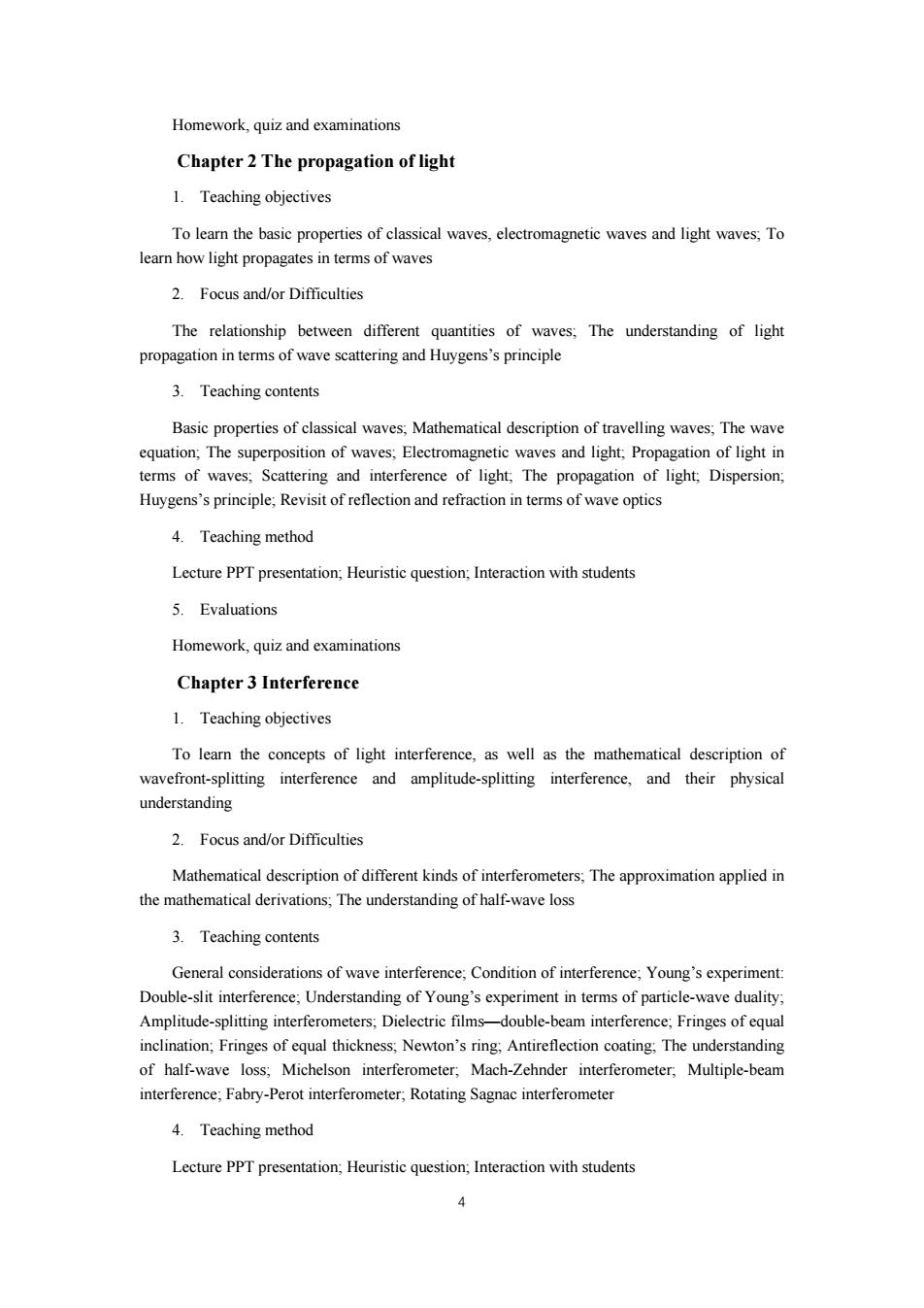
Homework,quiz and examinations Chapter 2 The propagation of light 1.Teachingobjectives To learn the basic properties of classical waves,electromagnetic waves and light waves,To learn how light propagates in terms of waves 2.Focus and/or Difficulties The relationship between different quantities of waves,The understanding of light propagation in terms of wave scattering and Huygens's principle 3.Teaching contents Basic properties of waves,Mathematical description of travelling waves,The wave equation,The superposition of waves,Electromagnetic waves and light;Propagation of light in terms of waves,Scattering and interference of light;The propagation of light,Dispersion, Huygens's principle;Revisit of reflection and refraction in terms of wave optics 4.Teaching method Lecture PPT presentation,Heuristicquestion Interaction with students 5.Evaluations Homework,quiz and examinations Chapter 3 Interference 1.Teaching objectives To learn the concepts of light interference,as well as the mathematical description of wavefront-splitting interference and amplitude-splitting interference.and their physical understanding 2.Focus and/or Difficulties Mathematical description of different kinds of interferometers.The approximation applied in the mathematical derivations;The understanding of half-wave loss 3.Teaching contents General considerations of wave interference,Condition of interference.Young's experiment Double-slit interference.Understanding of Young's experiment in terms of particle-wave duality. Amplitude-splitting interferometers;Dielectric films-double-beam interference:Fringes of equal inclination:Fringes of equal thickness:Newton's ring:Antireflection coating:The understanding of half-wave loss:Michelson interferometer Mach-Zehnder inter ferometer,Multiple-beam interference;Fabry-Perot interferometer,Rotating Sagnac interferometer 4.Teaching method Lecture PPT presentation:Heuristic question:Interaction with students
4 Homework, quiz and examinations Chapter 2 The propagation of light 1. Teaching objectives To learn the basic properties of classical waves, electromagnetic waves and light waves; To learn how light propagates in terms of waves 2. Focus and/or Difficulties The relationship between different quantities of waves; The understanding of light propagation in terms of wave scattering and Huygens’s principle 3. Teaching contents Basic properties of classical waves; Mathematical description of travelling waves; The wave equation; The superposition of waves; Electromagnetic waves and light; Propagation of light in terms of waves; Scattering and interference of light; The propagation of light; Dispersion; Huygens’s principle; Revisit of reflection and refraction in terms of wave optics 4. Teaching method Lecture PPT presentation; Heuristic question; Interaction with students 5. Evaluations Homework, quiz and examinations Chapter 3 Interference 1. Teaching objectives To learn the concepts of light interference, as well as the mathematical description of wavefront-splitting interference and amplitude-splitting interference, and their physical understanding 2. Focus and/or Difficulties Mathematical description of different kinds of interferometers; The approximation applied in the mathematical derivations; The understanding of half-wave loss 3. Teaching contents General considerations of wave interference; Condition of interference; Young’s experiment: Double-slit interference; Understanding of Young’s experiment in terms of particle-wave duality; Amplitude-splitting interferometers; Dielectric films—double-beam interference; Fringes of equal inclination; Fringes of equal thickness; Newton’s ring; Antireflection coating; The understanding of half-wave loss; Michelson interferometer; Mach-Zehnder interferometer; Multiple-beam interference; Fabry-Perot interferometer; Rotating Sagnac interferometer 4. Teaching method Lecture PPT presentation; Heuristic question; Interaction with students
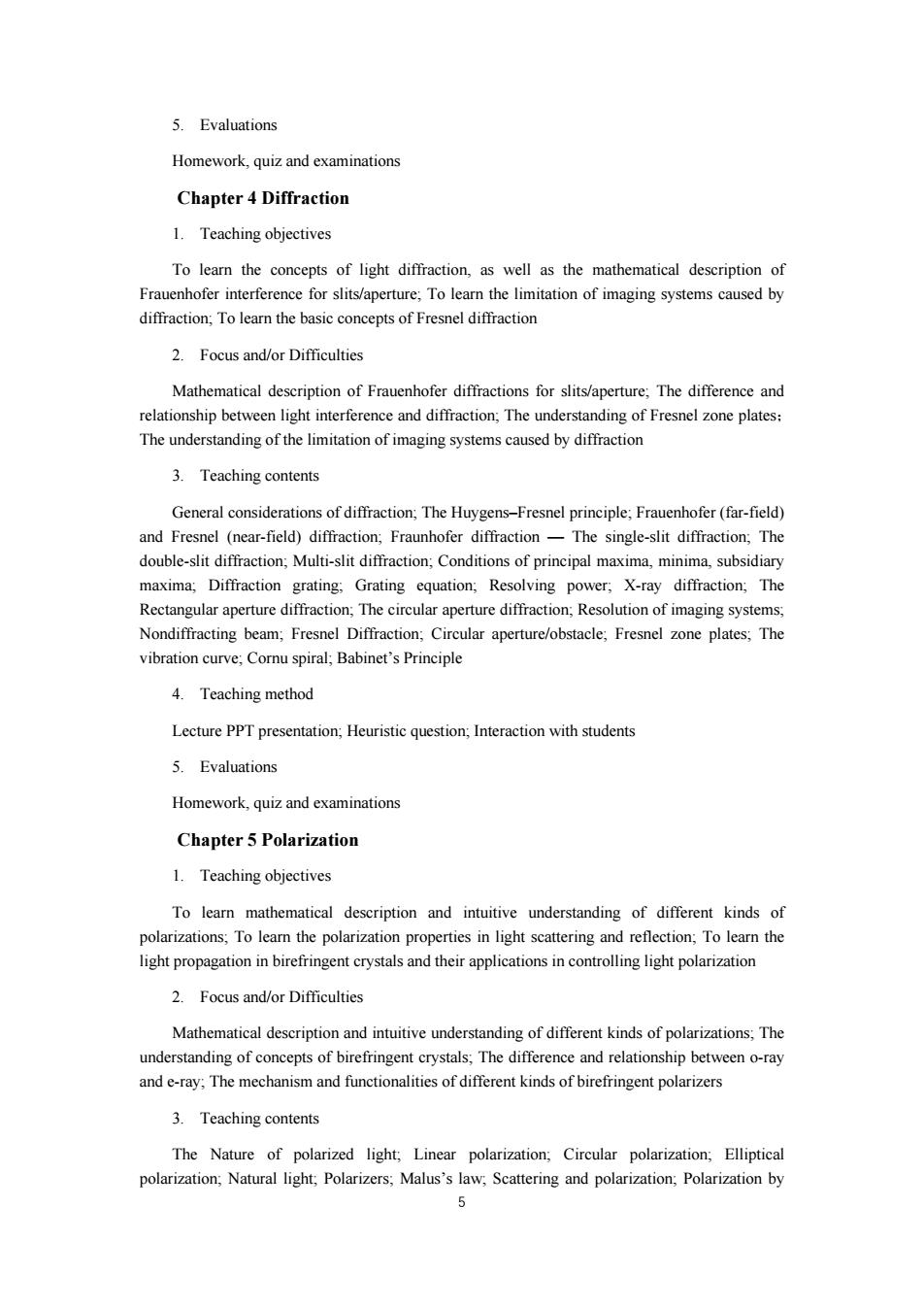
5.Evaluations Homework,quiz and examinations Chapter 4 Diffraction 1.Teaching objectives To learn the concepts of light diffraction,as well as the mathematical description of 2.Focus and/or Difficulties Mathematical description of Frauenhofer diffractions for slits/aperture.The difference and relationship between light The understanding of: 3.Teaching contents General considerations of diffraction:The Huygens-Fresnel principle:Frauenhofer(far-field) and Fresnel(near-field)diffraction,Fraunhofer diffraction-The single-slit diffraction;The double-sit diffraction,Multi-sit diffraction,Conditions of principal 1 ma ma,minima,subsidiar maxima;Diffraction grating.Grating equation;Resolving power,X-ray diffraction;The Rectangular aperture diffraction,The circular aperture diffraction,Resolution of imaging systems, Nondiffracting beam;Fresnel Diffraction;Circular aperture/obstacle;Fresnel zone plates;The vibration curve:Cornu spiral:Babinet's Principle 4.Teaching method Lecture PPT presentation;Heuristic question;Interaction with students 5.Evaluations Homework.quiz and examinations Chapter 5 Polarization 1.Teaching objectives To learn mathematical description and intuitive understanding of different kinds of 2.Focus and/or Difficulties Mathematical description and intuitive understanding of different kinds of polarizations;The understanding of concepts of birefringent crystals,The difference and relationship between o-ray and-ray,The mechanism and functi nalities kinds of birefringent polarizers 3.Teaching contents The Nature of polarized light,Linear polarization:Circular polarization.Elliptical polarization:Natural light:Polarizers:Malus's law:Scattering and polarization;Polarization by 5
5 5. Evaluations Homework, quiz and examinations Chapter 4 Diffraction 1. Teaching objectives To learn the concepts of light diffraction, as well as the mathematical description of Frauenhofer interference for slits/aperture; To learn the limitation of imaging systems caused by diffraction; To learn the basic concepts of Fresnel diffraction 2. Focus and/or Difficulties Mathematical description of Frauenhofer diffractions for slits/aperture; The difference and relationship between light interference and diffraction; The understanding of Fresnel zone plates; The understanding of the limitation of imaging systems caused by diffraction 3. Teaching contents General considerations of diffraction; The Huygens–Fresnel principle; Frauenhofer (far-field) and Fresnel (near-field) diffraction; Fraunhofer diffraction — The single-slit diffraction; The double-slit diffraction; Multi-slit diffraction; Conditions of principal maxima, minima, subsidiary maxima; Diffraction grating; Grating equation; Resolving power; X-ray diffraction; The Rectangular aperture diffraction; The circular aperture diffraction; Resolution of imaging systems; Nondiffracting beam; Fresnel Diffraction; Circular aperture/obstacle; Fresnel zone plates; The vibration curve; Cornu spiral; Babinet’s Principle 4. Teaching method Lecture PPT presentation; Heuristic question; Interaction with students 5. Evaluations Homework, quiz and examinations Chapter 5 Polarization 1. Teaching objectives To learn mathematical description and intuitive understanding of different kinds of polarizations; To learn the polarization properties in light scattering and reflection; To learn the light propagation in birefringent crystals and their applications in controlling light polarization 2. Focus and/or Difficulties Mathematical description and intuitive understanding of different kinds of polarizations; The understanding of concepts of birefringent crystals; The difference and relationship between o-ray and e-ray; The mechanism and functionalities of different kinds of birefringent polarizers 3. Teaching contents The Nature of polarized light; Linear polarization; Circular polarization; Elliptical polarization; Natural light; Polarizers; Malus’s law; Scattering and polarization; Polarization by
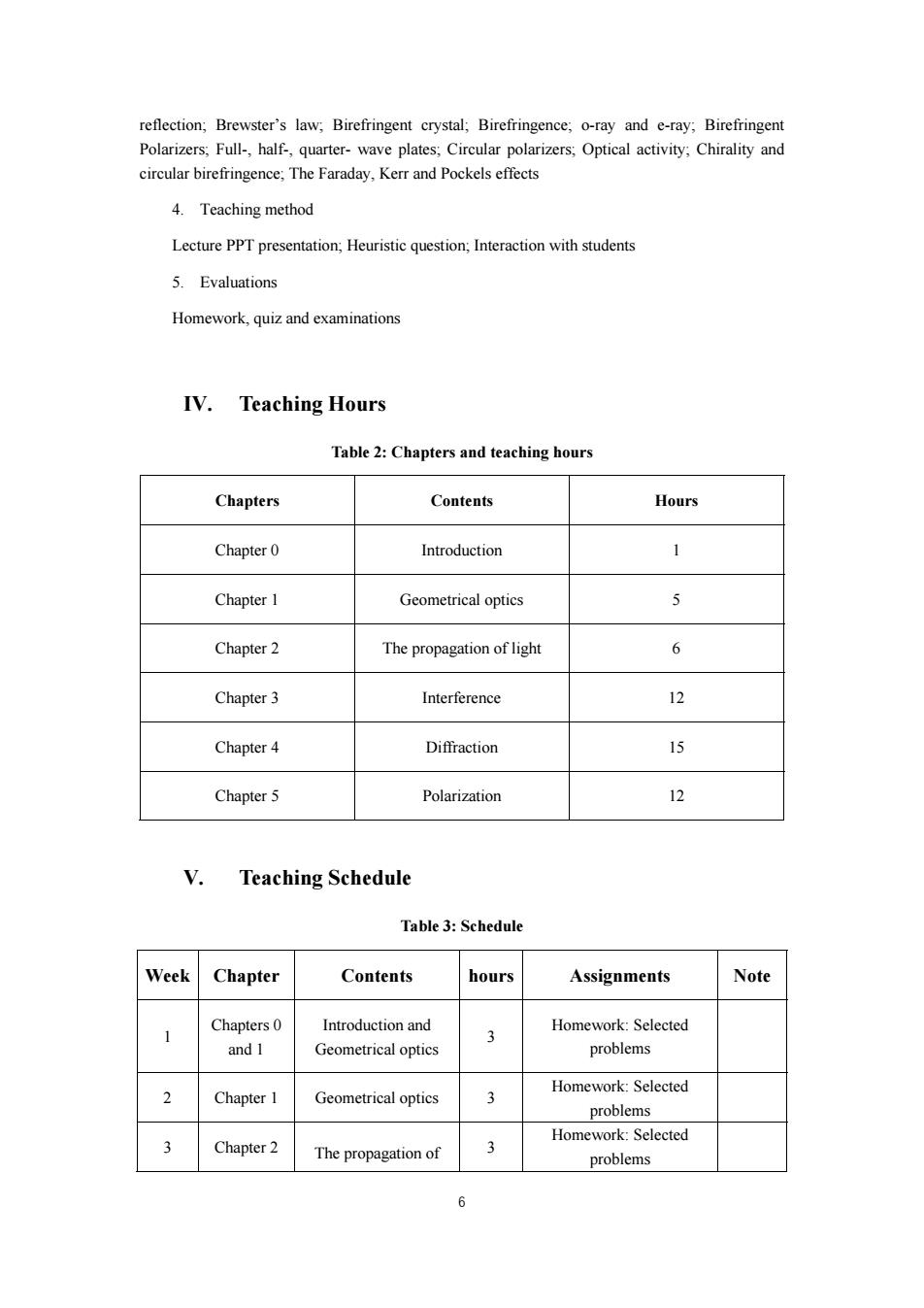
reflection:Brewster's law:Birefringent crystal:Birefringence:o-ray and e-ray:Birefringent circular birefringence The Faraday,Kerr and Pockels effect 4.Teaching method Lecture PPT presentation:Heuristic question:Interaction with students 5.Evaluations Homework.quiz and examinations IV.Teaching Hours Table 2:Chapters and teaching hours Chapters Contents Hours Chapter0 Introduction 1 Chapter 1 Geometrical optics 5 Chapter2 The propagation of light 6 Chapter 3 Interference 12 Chapter4 Diffraction 15 Polarization 12 V.Teaching Schedule Table 3:Schedule Week Chapter Contents hours Assignments Note Chapters0 Geometrical optics 3 Homework:Selected problems Homework:Selected Chapter 1 Geometrical optics 3 problems Homework:Selected 3 Chapter 2 The propagation of 3 problems 6
6 reflection; Brewster’s law; Birefringent crystal; Birefringence; o-ray and e-ray; Birefringent Polarizers; Full-, half-, quarter- wave plates; Circular polarizers; Optical activity; Chirality and circular birefringence; The Faraday, Kerr and Pockels effects 4. Teaching method Lecture PPT presentation; Heuristic question; Interaction with students 5. Evaluations Homework, quiz and examinations IV. Teaching Hours Table 2: Chapters and teaching hours Chapters Contents Hours Chapter 0 Introduction 1 Chapter 1 Geometrical optics 5 Chapter 2 The propagation of light 6 Chapter 3 Interference 12 Chapter 4 Diffraction 15 Chapter 5 Polarization 12 V. Teaching Schedule Table 3: Schedule Week Chapter Contents hours Assignments Note 1 Chapters 0 and 1 Introduction and Geometrical optics 3 Homework: Selected problems 2 Chapter 1 Geometrical optics 3 Homework: Selected problems 3 Chapter 2 The propagation of 3 Homework: Selected problems

light Chapter 2 The propagation of Homework:Selected light problems Homework:Selected Chapter 3 Interference 3 problems Chapter3 Interference 3 Homework:Selected problems Chapter 3 Interference Homework:Selected 3 problems Chapter 3 Interference 3 Homework:Selected problems Homework:Selected Chapter 4 Diffraction problems 10 Chapter 4 Diffraction 3 Homework:Selected problems Homework:Selected Chapter 4 Diffraction problems Homework:Selected 12 Chapter4 Diffraction 3 problems Homework:Selected 13 Chapter 4 Diffraction problems Homework:Selected Chapter 5 Gravitation problems Chapter 5 Polarization 3 Homework:Selected problems 6 Homework:Selected Chapter 5 Polarization problems 17 Chapter 5 Polarization 3 None VI.References 1."Introduction to Optics"by Frank L Pedrotti,Leno M Pedrotti,Leno S Pedrotti 2."Optics"by Ajoy Ghatak,4th edition. 3.《光学教程》第四版姚启钧著 VII.Teaching method 7
7 light 4 Chapter 2 The propagation of light 3 Homework: Selected problems 5 Chapter 3 Interference 3 Homework: Selected problems 6 Chapter 3 Interference 3 Homework: Selected problems 7 Chapter 3 Interference 3 Homework: Selected problems 8 Chapter 3 Interference 3 Homework: Selected problems 9 Chapter 4 Diffraction 3 Homework: Selected problems 10 Chapter 4 Diffraction 3 Homework: Selected problems 11 Chapter 4 Diffraction 3 Homework: Selected problems 12 Chapter 4 Diffraction 3 Homework: Selected problems 13 Chapter 4 Diffraction 3 Homework: Selected problems 14 Chapter 5 Gravitation 3 Homework: Selected problems 15 Chapter 5 Polarization 3 Homework: Selected problems 16 Chapter 5 Polarization 3 Homework: Selected problems 17 Chapter 5 Polarization 3 None VI. References 1. “Introduction to Optics” by Frank L Pedrotti, Leno M Pedrotti, Leno S Pedrotti 2. “Optics” by Ajoy Ghatak, 4th edition. 3. 《光学教程》第四版 姚启钧著 VII. Teaching method

1.Lecture:PPT plus writing on the blackboard.Outlines,examples,schematic pictures and cartoon or movies are shown by PPT while derivations and solutions are performed on the blackboard.Examples are selected from the above listed reference books. 2.Preview:All students are asked to preview the context before class 3.Self-education:Students need to study"Fourier Optics"and"Modem Optics"by themselves. VIII.Assessment and Grading A.Correlations between assessment and course objectives Table 4:Correlations between assessment and course objectives Objectives Assessment points Way of assessment Performance Quiz Objective1 All teaching contents Midterm Exam+Final Exam Objective2 All teaching contents Performance+Quiz+ Midterm Exam+Final Exam Performance+ouiz+ Objective3 All teaching contents Midterm Exam+Final Exam Objective4 Performance+Quiz+ All teaching contents Midterm Exam+Final Exam B.Grading 1.Grading Scheme Performance 10%(including question answering 5%,homework 5%),Three quizzes45%. Midterm exam 20%;Final exam 25%. 2.Percentages in the assessment and Degrees of accomplishment of the objectives Table 5:Percentages in the assessment and Degrees of accomplishment of the objectives Peceatages Performance Quiz(3)Midterm Final exam Degree of
8 1. Lecture: PPT plus writing on the blackboard. Outlines, examples, schematic pictures and cartoon or movies are shown by PPT while derivations and solutions are performed on the blackboard. Examples are selected from the above listed reference books. 2. Preview: All students are asked to preview the context before class. 3. Self-education: Students need to study “Fourier Optics” and “Modern Optics” by themselves. VIII. Assessment and Grading A. Correlations between assessment and course objectives Table 4: Correlations between assessment and course objectives Objectives Assessment points Way of assessment Objective 1 All teaching contents Performance + Quiz + Midterm Exam + Final Exam Objective 2 All teaching contents Performance + Quiz + Midterm Exam + Final Exam Objective 3 All teaching contents Performance + Quiz + Midterm Exam + Final Exam Objective 4 All teaching contents Performance + Quiz + Midterm Exam + Final Exam B. Grading 1.Grading Scheme Performance 10% (including question answering 5%, homework 5%); Three quizzes 45%; Midterm exam 20%; Final exam 25%. 2.Percentages in the assessment and Degrees of accomplishment of the objectives Table 5: Percentages in the assessment and Degrees of accomplishment of the objectives Percentages Performance Quiz (3) Midterm Final exam Degree of
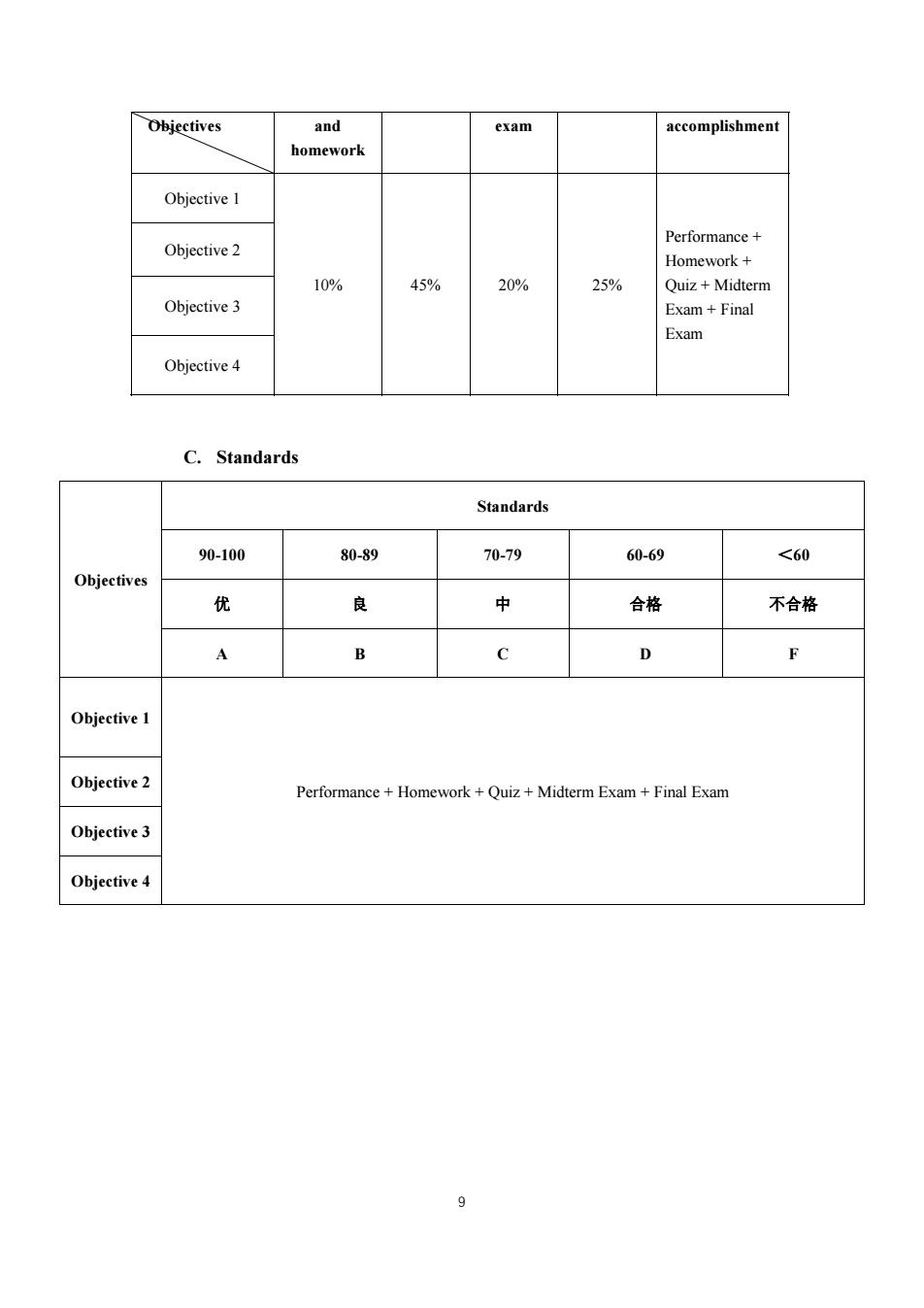
Objectives and exam accomplishment homework Objective I Performance+ Objective2 Homework+ 10% 45% 20% 25% Quiz+Midterm Objective3 Exam+Final Exam Objective 4 C.Standards Standards 90-100 80-89 70-79 60-69 <60 Objeetives 优 良 中 合格 不合格 B c D F Objective2 Performance+Homework+Quiz+Midterm Exam+Final Exam Objective3 Objective4
9 Objectives and homework exam accomplishment Objective 1 10% 45% 20% 25% Performance + Homework + Quiz + Midterm Exam + Final Exam Objective 2 Objective 3 Objective 4 C. Standards Objectives Standards 90-100 80-89 70-79 60-69 <60 优 良 中 合格 不合格 A B C D F Objective 1 Performance + Homework + Quiz + Midterm Exam + Final Exam Objective 2 Objective 3 Objective 4